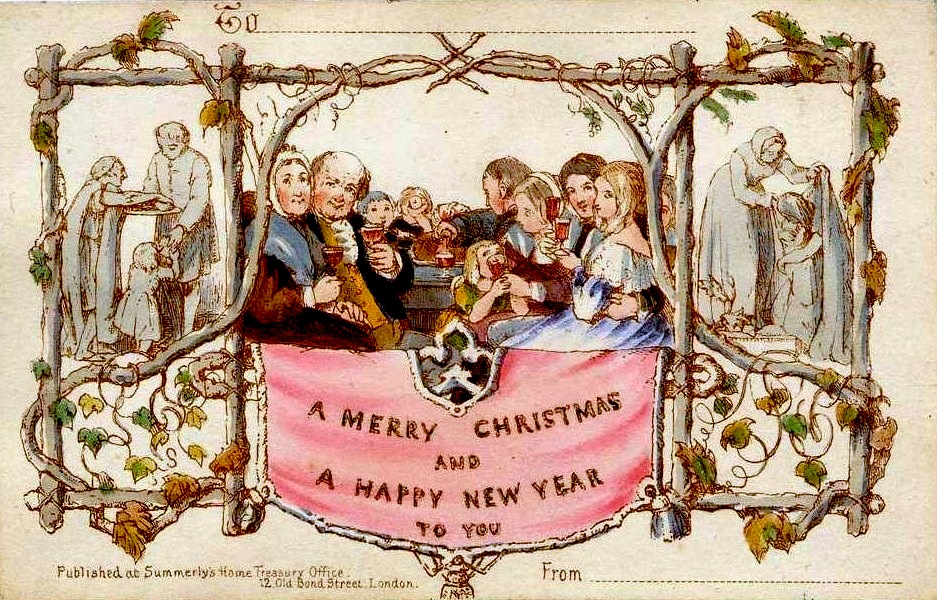
Santa down the chimney: In ancient pagan Germany smoke escaped through a hole in the roof rather than up a chimney, the winter solstice was dedicated to Hertha, the goddess of domesticity. The room was decked with evergreens and a great fire was laid on a large, flat altar stone set in the center. In the midst of feasting, the goddess would descend through the smoke to bestow good luck on the host and his guests. The Hertha stone became our hearthstones, and the legend explains why Santa Claus comes down the chimney.
Carols: The word is said to derive from the Latin cantare, to sing, and rola, an expression of joy, and earliest surviving texts dates are from the thirteenth century. But caroling being a monastic activity, it fell into disfavor in the reign of Henry VIII, later revived in more secular forms only to be condemned by the Puritans. It took the British and American colonists most of the 18th century to get over that issue, and by then old-style carols were considered antiquated. It was not until the nineteenth century that most of the carols we now sing were written. “Silent Night” was first published in 1840, “Hark the Herald Angels Sing” in 1856, “O Come, All Ye Faithful” was not translated into English until 1841, and “O Little Town of Bethlehem” was written for a Philadelphia Sunday School in 1868. 
 Christmas Trees: In the Northern hemisphere, the shortest day and longest night of the year falls on December 21 or December 22. Long before the advent of Christianity, plants and trees that remained green all year had a special meaning for people in the winter. Early Romans marked the solstice with a feast called the Saturnalia in honor of Saturn, the god of agriculture and provided the occasion for a week of gift giving and revelry. The solstice meant that soon farms and orchards would again be green and fruitful. To mark the occasion, they decorated their homes and temples with evergreen boughs. In Northern Europe Druids, the priests of the ancient Celts, also decorated their temples with evergreen boughs and holly as a symbol of everlasting life. Germany is credited with starting the Christmas tree tradition as we now know it in the 16th century when devout Christians brought decorated trees into their homes. Some built Christmas pyramids of wood and decorated them with evergreens and candles. In 1846, the popular royals, Queen Victoria and her German Prince, Albert, were sketched in the Illustrated London News standing with their children around a Christmas tree, and what was done at court immediately became fashionable—not only in Britain, but with fashion-conscious East Coast American Society. The Christmas tree had arrived.
Christmas Trees: In the Northern hemisphere, the shortest day and longest night of the year falls on December 21 or December 22. Long before the advent of Christianity, plants and trees that remained green all year had a special meaning for people in the winter. Early Romans marked the solstice with a feast called the Saturnalia in honor of Saturn, the god of agriculture and provided the occasion for a week of gift giving and revelry. The solstice meant that soon farms and orchards would again be green and fruitful. To mark the occasion, they decorated their homes and temples with evergreen boughs. In Northern Europe Druids, the priests of the ancient Celts, also decorated their temples with evergreen boughs and holly as a symbol of everlasting life. Germany is credited with starting the Christmas tree tradition as we now know it in the 16th century when devout Christians brought decorated trees into their homes. Some built Christmas pyramids of wood and decorated them with evergreens and candles. In 1846, the popular royals, Queen Victoria and her German Prince, Albert, were sketched in the Illustrated London News standing with their children around a Christmas tree, and what was done at court immediately became fashionable—not only in Britain, but with fashion-conscious East Coast American Society. The Christmas tree had arrived.
Cards: The earliest known card was created and mailed in 1845 by Victorian painter William Charles Dobson. A year later, another painter, John Calcott Horsley, was asked to provide a lithographed card to be sent out by the too-busy Sir Henry Cole, keeper of the records at the British Treasury Office, and thanks to him we have ever since been wishing one and all a Merry Christmas and a Happy New
